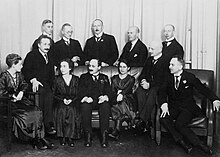Walter Grotrian

Walter Robert Wilhelm Grotrian (born April 21, 1890 in Aachen , † March 3, 1954 in Potsdam ) was a German astronomer and astrophysicist .
Life
Grotrian was first a private lecturer at the University of Potsdam , where he completed his habilitation in 1921. In 1922 he was appointed as an observer at the Potsdam Astrophysical Observatory (Einstein Institute) and from then on belonged to the University of Berlin . In 1941 in the Third Reich he became managing director of the German Physical Society . During the Second World War he served as a major in the Wehrmacht . He worked with Peter Wellmann (1913–1999), Johannes Plendl and Karl-Otto Kiepenheuer to create a European network of stations to record the variable radiation from the sun. The radio communications company led by him provided not only the personnel for the ionosphere stations but also the personnel for these stations.
In 1940 he was on an official assignment in this context (he was with the Air Force at the time) in occupied Norway to establish contacts with Norwegian physicists, in particular with the observatory in Tromsø (for the purpose of ionospheric observation, which the Germans ultimately carried out there independently), and he was also Svein Visited Rosseland in Oslo. This was later compared to Heisenberg's role in Copenhagen in 1941 with Niels Bohr and was a point of conflict in the correspondence with Lise Meitner , with whom he wanted to renew the old friendship after the war in 1947.
plant
Grotrian mainly dealt with spectroscopy and its application to explain astrophysical phenomena. His most important work is the "Graphical representation of the spectra of atoms and molecules with 1, 2 and 3 valence electrons", published in 1928, with which he established today's representation of term schemes as Grotrian diagrams . He made a second important discovery with the help of data he had gained on an expedition to Sumatra under Erwin Freundlich in 1929 , namely a correct physical explanation of the spectrum of the solar corona and thus an estimate of its temperature at over a million degrees Celsius. He also discovered clouds of dust as an explanation of the zodiacal light .
The moon crater Grotrian is named after him.
swell
- ↑ Dieter Hoffmann: "Between autonomy and adaptation: The German Physical Society in the Third Reich". Max Planck Institute for the History of Science, Preprint 192 (2001) (pdf; 69 kB).
- ↑ Michael P.Seiler: Command matter "sun god". History of German solar research in the Third Reich and under Allied occupation . Harri Deutsch, Frankfurt 2006.
- ↑ Dieter Hoffmann in Michael Frayn Copenhagen (Michael Dörries ed.), Wallstein 2003
- ↑ Hoffmann and z. B. Philip Ball Serving the Empire. The struggle for the soul of physics under Hitler , Bodley Head 2013
literature
- Short biography for: Grotrian, Walter Robert Wilhelm . In: Who was who in the GDR? 5th edition. Volume 1. Ch. Links, Berlin 2010, ISBN 978-3-86153-561-4 .
- Harald von Klüber: Grotrian, Walter Robert Wilhelm. In: New German Biography (NDB). Volume 7, Duncker & Humblot, Berlin 1966, ISBN 3-428-00188-5 , p. 169 f. ( Digitized version ).
Web links
- Literature by and about Walter Grotrian in the catalog of the German National Library
- Publications by W. Grotrian in the Astrophysics Data System
- Obituaries for W. Grotrian in the Astrophysics Data System
- Astrophysical Institute Potsdam: "80 Years Einstein Tower - 50th Anniversary of the Death of Walter Grotrian"
| personal data | |
|---|---|
| SURNAME | Grotrian, Walter |
| ALTERNATIVE NAMES | Grotrian, Walter Robert Wilhelm |
| BRIEF DESCRIPTION | German astronomer and astrophysicist |
| DATE OF BIRTH | April 21, 1890 |
| PLACE OF BIRTH | Aachen |
| DATE OF DEATH | March 3, 1954 |
| Place of death | Potsdam |